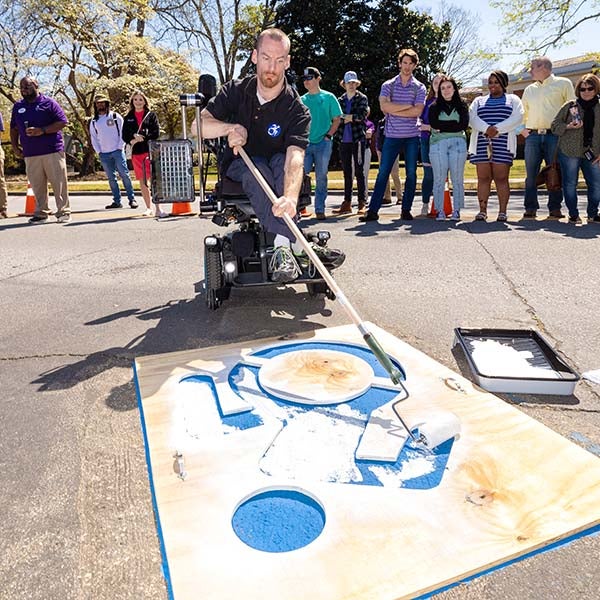Transition to updated accessible icon begins on main campus
The Hildreth family’s roots were in Reading, Mass., for decades until 2012, when a move to New Bern made eastern North Carolina home. A significant part of that process was sealed Friday with an East Carolina University ceremony to unveil a change to an updated, more active looking accessible parking icon.

ECU student Brendon Hildreth paints an updated, more active accessible icon on main campus. (Photos by Rhett Butler)
Brendon Hildreth, who has cerebral palsy and is on the brink of graduation at ECU in industrial technology with a concentration in mechanical design technology, has been at the forefront of this change. The Hildreth family has worked with Dr. David Loy, associate professor in the Department of Recreation Sciences, as part of the Design4Disability prevention science initiative within the College of Health and Human Performance.
Three parking spots on main campus were painted to display the more active icon. Plans for the coming months include updating all 337 accessible spots on campus.
“Moving from Reading was one of the hardest things I’ve ever done, but something like this makes it all worth it,” said Darcy Hildreth, Brendon’s mother. “This is amazing. Right now, it is all good.”
The International Symbol of Accessibility was designed in 1968, portraying a stationary person using a wheelchair and not independent. The new design pictures an individual with a disability with their upper body tilted forward, indicating their mobility and they are in control of their direction.
The Hildreth family moved to New Bern for Brendon to attend Craven Community College before he transferred to ECU. Darcy said the family is thankful for the high level of inclusion shown by Craven Community College and ECU toward Brendon.
Brendon, ECU Chancellor Philip Rogers and ECU student body president Chandler Ward served as the first ceremonial painters.
“This marks a special occasion at East Carolina University to be able to truly embrace this concept of a forward trajectory of our institution as we join in the accessible icon project here at ECU,” Rogers said. “We couldn’t have asked for a more picture-perfect day to celebrate. This makeover that we are celebrating today gives new meaning, gives new life and gives new recognition to individuals with disabilities. We hope that the icon, especially on our campus, will impact in a way we continue to celebrate individuals with disabilities in our community. Adopting this symbol offered by this project is yet another example of our campus community coming together.”
This initiative was sparked by collaboration between Loy, ECU Vice Chancellor for Student Affairs Dr. Virginia Hardy, and Josh Puckett, enforcement supervisor with ECU Parking and Transportation. Inner Banks Paint and Decorating also is donating about $4,000 worth of Benjamin Moore paint for the project.

Chancellor Philip Rogers, left, and ECU student body president Chandler Ward paint a parking spot outside the Spilman Building to display an updated, more active accessible icon.
“To make this change, no one ever said no. They said, ‘How,’” Loy said. “That is the spirit of East Carolina University.”
Loy assisted in Brendon Hildreth’s remarks as Hildreth addressed the crowd at Friday’s event prior to painting.
“The new, moving forward icon means that people can see a person with a disability as being more active, and capable,” Hildreth said while using a communication device. “We are not just like robots, which is what the old symbol looks like. The old symbol makes me think of the word handicap, which started from disabled people being sent out to the street with a cap in hand to beg for money. That is why I like the change to the accessible icon. It is important to me to show others that we are human beings with disability rights. We all belong.”
Stephen Gray, director of ECU’s Department for Disability Support Services, emphasized Hildreth’s determination as an example of student advocacy for inclusion and student success.
“It is my responsibility that our students progress forward, not stay put,” Gray said. “I’ve known Brendon and his mom, Darcy, since Brendon became part of the DSS family in August of 2018. I’ve seen remarkable progress in not only his academics, but also him personally. He is a great communicator, albeit a little slower, but he lives his life to the fullest. … He has overcome challenges with hard work and determination. Today is about movement, it’s about progress and it’s about a student’s vision for this and our next generation.”